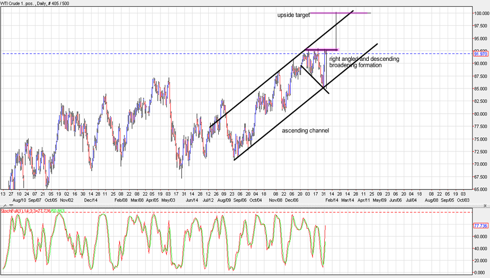
WTI Crude soared back to $92.84 per barrel yesterday (January 31, 2011) during the height of the social and political unrest in Egypt. Aside from the negative sentiment that the crisis has brought, traders were also worried that the people’s uprising could interrupt the flow of trade in Suez Canal. Like I said in my previous post (kindly see it here), about 8% to 10% of global sea trade with 1 million to 1.6 million barrels of crude oil per day pass through the canal. Another 3 million or so barrels of crude oil pass through an adjacent pipeline, putting the total to about 4.7% of the global output. Hence, any disruption in the canal could cause a shortage in global oil supply. In fact, some major shipping lines like AP Moller-Maersk had already halted their operations.
On the technical side, the price of WTI crude oil had risen sharply from a low of $85.11 per barrel on Friday to a high of $92.84 yesterday. As you can see from its daily chart above, WTI crude oil has been trading within an ascending channel for several months now. From mid-December of 2010, it has started to form a right-angled and descending broadening formation. And from the looks of it, it appears that it is already ripe for an upside breakout. In the event the prices of WTI crude oil move past $92.50, it could further rise and touch the psychological $100.00 marker. On the flip side, it could once again head towards the support of the ascending channel if it fails to break above $92.50. But given the channel’s present direction, the chances that the price of WTI crude oil moving north is higher.
Higher crude oil prices could weigh on the equities markets since such makes the cost of running industries more expensive. As you all know, majority of the world’s energy comes from petroleum. While such could negatively impact the global businesses in general, on the one hand, it could also benefit the companies that produce or refine oil especially if they are able to hedge their inventories on lower prices.
WTI Crude soared back to $92.84 per barrel yesterday (January 31, 2011) during the height of the social and political unrest in Egypt. Aside from the negative sentiment that the crisis has brought, traders were also worried that the people’s uprising could interrupt the flow of trade in Suez Canal. Like I said in my previous post (kindly see it here), about 8% to 10% of global sea trade with 1 million to 1.6 million barrels of crude oil per day pass through the canal. Another 3 million or so barrels of crude oil pass through an adjacent pipeline, putting the total to about 4.7% of the global output. Hence, any disruption in the canal could cause a shortage in global oil supply. In fact, some major shipping lines like AP Moller-Maersk had already halted their operations.
On the technical side, the price of WTI crude oil had risen sharply from a low of $85.11 per barrel on Friday to a high of $92.84 yesterday. As you can see from its daily chart above, WTI crude oil has been trading within an ascending channel for several months now. From mid-December of 2010, it has started to form a right-angled and descending broadening formation. And from the looks of it, it appears that it is already ripe for an upside breakout. In the event the prices of WTI crude oil move past $92.50, it could further rise and touch the psychological $100.00 marker. On the flip side, it could once again head towards the support of the ascending channel if it fails to break above $92.50. But given the channel’s present direction, the chances that the price of WTI crude oil moving north is higher.
Higher crude oil prices could weigh on the equities markets since such makes the cost of running industries more expensive. As you all know, majority of the world’s energy comes from petroleum. While such could negatively impact the global businesses in general, on the one hand, it could also benefit the companies that produce or refine oil especially if they are able to hedge their inventories on lower prices.
More on LaidTrades.com …